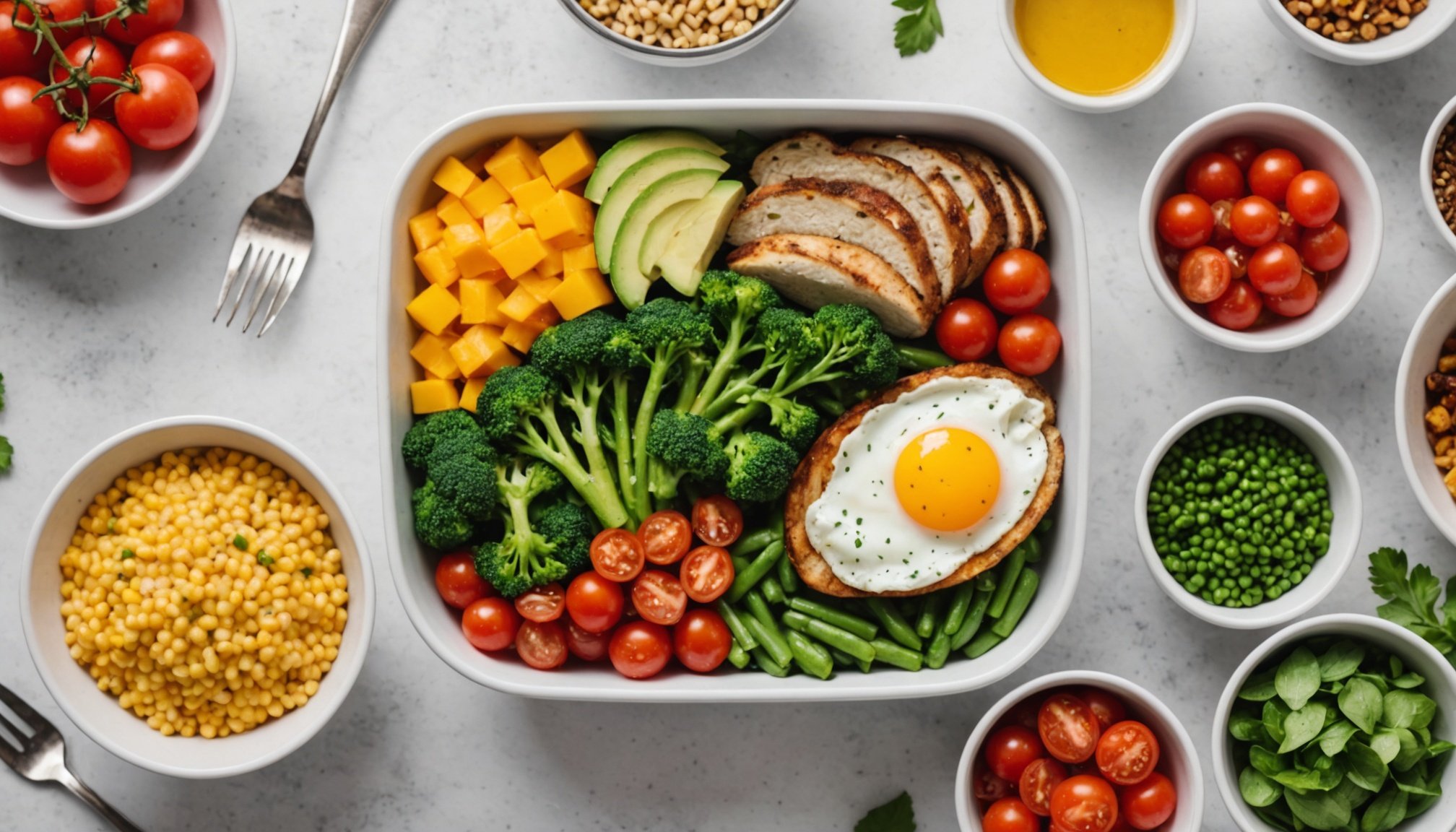Understanding Nutritional Needs
Nutritional guidelines are essential for maintaining health, but they vary based on individual dietary requirements. Macronutrients, which include carbohydrates, proteins, and fats, provide energy and are crucial for bodily functions. Micronutrients, such as vitamins and minerals, are equally vital for the body’s biochemical processes.
Individual dietary needs can be influenced by several factors, including age, gender, and activity level. For instance, children require more calories and nutrients to support growth, whereas adults might need fewer calories to maintain weight. Similarly, an athlete with a high activity level might need more energy-dense foods than a sedentary individual. Understanding these requirements can help tailor a diet that meets personal health goals.
In the same genre : Unlocking calm: binaural beats for anxiety relief
Balanced meals play a critical role in supporting overall wellbeing. They ensure that all essential nutrients are consumed in appropriate proportions, which is vital for maintaining energy levels, supporting immune function, and promoting mental health. Adopting a diet that aligns with one’s specific nutritional needs can lead to better health outcomes and enhance quality of life. Therefore, following these guidelines helps accommodate individual differences and fosters a healthier lifestyle.
Budgeting for Meal Planning
Efficient budget meal planning begins with establishing a weekly grocery budget—an essential tool for managing expenses. Deciding on a reasonable amount requires evaluating how much you typically spend and identifying where you can save. Focusing on cost-effective shopping strategies aids in adhering to this budget while ensuring nutritional needs are met.
Topic to read : Find your path with an online jungian analyst today
Prioritising essential ingredients is another key to cost savings. By focusing on versatile items, you can create various meals without expanding your shopping list significantly. Staples such as rice, pasta, and fresh produce should take precedence as they can be used in multiple dishes, offering flexibility and reducing wastage.
Making the most of seasonal and bulk purchasing strategies further enhances your budgeting efforts. Buying seasonal produce typically costs less and tastes better, offering both monetary and quality benefits. Bulk purchasing, especially of non-perishable items like grains and legumes, can drastically reduce costs when you have the storage space for these goods.
A combination of these strategies not only supports a sustainable grocery bill but also encourages healthier eating habits. By thoughtfully planning around these points, you can enjoy diverse meals that don’t break the bank, proving that affordable and nutritious meals are well within reach.
Easy and Nutritious Recipes
Creating budget-friendly recipes without sacrificing taste or nutrition is possible with some strategic planning. Embrace the ingredients that are both inexpensive and nutritious to craft meals for any time of the day.
Breakfast Ideas
Kickstart your day with satisfying, healthy meals that won’t break the bank. Consider whipping up a hearty oatmeal mix; oats are incredibly affordable and versatile. Add fruits or nuts for extra taste and nutritional value. Additionally, make smoothies using frozen fruits and leafy greens for a swift, nourishing breakfast.
Lunch Options
When it comes to midday meals, simplicity and health should front. Salads made with mixed greens, beans, and homemade dressings can be a game-changer. They are not only budget-friendly but also quick to prepare. Invest in whole grains like quinoa or brown rice, which offer a substantial energy boost when paired with vegetables or lean proteins.
Dinner Recipes
End your day with comforting dinner recipes that deliver on flavour and nourishment. Lentil soup, for instance, is cost-effective and rich in protein and fibre. Incorporate meal prep strategies such as cooking in batches; this not only saves time but also ensures you have healthy meals ready when needed. Preparing multiple servings will help manage your budget efficiently.
Shopping for Healthy Ingredients
Navigating grocery aisles can be challenging when aiming to make healthier food choices. One effective strategy is to start by reading labels meticulously. Look out for hidden sugars and unhealthy fats which can often lurk in seemingly healthy products. Aim for items with fewer ingredients, especially those you can easily recognize and pronounce.
Another fantastic method is to explore your local farmers’ market. These markets offer fresh produce often at peak ripeness, providing nutrient-rich options that make it easier to maintain a balanced diet. By purchasing locally, you are not only supporting your community but often obtaining products that have been harvested more recently than those found in grocery stores.
Planning meals before you go shopping can significantly affect your ability to make good choices. Prepare a list of ingredients needed for your meals to avoid impulse buys, which often tend towards processed and less healthy options. This method keeps you focused and makes sure you have everything necessary for a week’s worth of nutritious meals.
Following these grocery shopping tips ensures that you fill your pantry with healthful and wholesome ingredients, fostering a sustainable and nutritious eating habit.
Meal Planning Templates and Tools
Effective meal planning resources can significantly simplify your weekly cooking routine. Start by exploring printable templates that cater to various dietary needs and meals. These templates often allow you to outline breakfast, lunch, and dinner plans, saving time and helping maintain a balanced diet.
For those tech-savvy planners, numerous apps offer meal planning resources. These digital tools often include features like setting budgets, tracking nutrition, and suggesting recipes based on the ingredients already in your kitchen. Such mobile apps can be invaluable for those wanting to stick to a meal plan while keeping costs in check.
Customizing your meal plans ensures they align with both personal preferences and nutritional requirements. Begin by identifying staple ingredients your family enjoys. Adjust your templates to incorporate these items consistently. This not only ensures satisfaction but also minimizes waste and makes meal-prepping a breeze.
Additionally, regularly revisiting and updating your printable templates or app settings can keep meals exciting and prevent monotony. With the right meal planning resources, the task can transform from a chore into an enriching and satisfying activity.
Adapting Meal Plans for Dietary Preferences
Adapting meal plans to cater to individual dietary restrictions can greatly enhance the dining experience for those with specific dietary needs. Designing meals that accommodate vegetarian and vegan diets often involves modifying traditional recipes. By simply altering or substituting ingredients—such as using tofu instead of meat in stir-fry or opting for coconut milk in soups—one can create delicious, plant-based versions of classic dishes.
Incorporating diverse cuisines is another effective strategy to keep meals exciting. By exploring ingredients and cooking methods from around the world, you can introduce a variety of flavors and textures into a diet, making meals more appealing and nutritious. For example, Indian, Middle Eastern, or Mexican cuisines often offer naturally vegan or vegetarian dishes that can easily satisfy dietary preferences.
For those concerned with cost, it’s reassuring to note that many affordable substitutes exist for meeting specific dietary needs. Ingredients like lentils, chickpeas, and seasonal vegetables provide budget-friendly options for protein and nutrients. Additionally, these ingredients can be purchased in bulk, reducing overall costs while still supporting a well-rounded diet tailored to individual dietary restrictions. This way, delicious and satisfying meals remain within reach for all.
Overcoming Common Meal Planning Challenges
Facing meal planning obstacles can be frustrating, but practical solutions are within reach. One common hurdle is limited cooking time. To combat this, consider preparing meals in bulk and freezing portions for future use. This not only saves time but can also encourage healthier eating by reducing reliance on takeout. Planning quick and easy recipes, like stir-fries or one-pot dishes, can further ease the burden.
Managing leftovers wisely prevents waste and maximises your grocery budget. Transforming Wednesday’s roast into Thursday’s sandwich fillings or Friday’s soup ensures nothing goes to waste. Creating a leftover night each week can be a fun way for the family to experiment and appreciate previous meals while reducing food waste.
Lastly, keeping the family engaged in meal planning can enhance the experience and spread the workload. Involve children by inviting them to choose dishes or help with prep. Hosting a weekly family meal planning session encourages everyone to share preferences, resulting in meals that satisfy all tastes. This collaborative approach can make meal planning not only manageable but enjoyable for everyone involved.
Staying Motivated and Consistent
Developing and maintaining meal planning motivation can be challenging, but setting realistic goals is a great starting point. Begin by establishing achievable milestones for your healthy eating habits. This could include meal prepping twice a week or incorporating more vegetables into your diet. Align your goals with your lifestyle to ensure they are sustainable.
Tracking progress is crucial for staying motivated. Consider using a journal or an app to document your meal planning success. Celebrate each small victory, whether it’s trying a new recipe or consistently preparing balanced meals. Recognising these achievements keeps the momentum going and reinforces your commitment to healthy eating habits.
Engaging with communities can provide additional support and inspiration. Whether through online forums, social media groups, or local cooking classes, connecting with others on a similar journey can boost your motivation. Sharing experiences, tips, and recipes encourages a sense of camaraderie and accountability, making the process enjoyable.
By setting realistic goals, tracking achievements, and seeking community support, you’ll cultivate a sustainable and motivating environment for your meal planning endeavours. With these strategies in place, maintaining meal planning motivation becomes more manageable, leading to lasting healthy eating habits.











